Special Techniques
Presentations of the Left Hand
The Left Hand
When guitarists mention the word tired, they usually refer to the left hand. This is due to the most widespread error of them all: To think fingers when thinking of playing notes. The correct way to see the left hand is to see it as different ways to present the hand and the fingers, simply stopping the correct notes. Presentation is a very used word in South America in circumstances like: "The gardener presents the plant in the place where it will eventually be planted, then, he digs a hole and literally plants it". To present is a way to say "put it in a way that is self illustratory"; "Almost the same as the real thing". When applied to the left hand, the word indicates that the arm does the whole job except for the very final one: press the string.
But the one most important factors to be kept in mind and often neglected by guitarists in general is that the left hand must work with as little or no pressure between the thumb and the opposing fingers. To squeeze the neck hard will only make your left hand clumsy and you will sound poorly at best. This is without any doubt the #1 technique secret regarding the Left Hand.
In the video Below I illustrate how the work of the left hand is actually the sum of the work of the shoulder, elbow, forearm, wrist. The work of the left hand fingers is not an isolated task of the fingers themselves .
Video: How to move the hand on the fingerboard using the whole playing apparatus.
Presentation Explained
Typically, a musical scenario is made up of several technical challenges, therefore, play really slowly at first in order to acquire the right moves. Have faith, this approach makes your right hand into an obedient, smooth machine. I will show you another example in slow motion taken from Queen's "Love of My life" staff #3 (form the mangore.com online masterclass), where the left hand undergoes a series of changes of Presentation. Notice how these are usually preceded by a relaxation of the left hand. This is done so in order to avoid string squeaks:

Types of Presentations
Carlevaro had to adapt some existing and non existing words in order to explain some of his technical concepts. Presentation, the way the left hand hand looks with respect to the fret board, he divided in 3 types:
1- Longitudinal.
2- Transversal.
3- Mixed.
In the animation below, taken from the masterclass on Mozart's "Turkish March" staff #36 & #37, you see how the arm helps position the left hand fingers and helps change their presentation on the fingerboard from Transversal to Longitudinal with a small push forward that comes from the elbow.
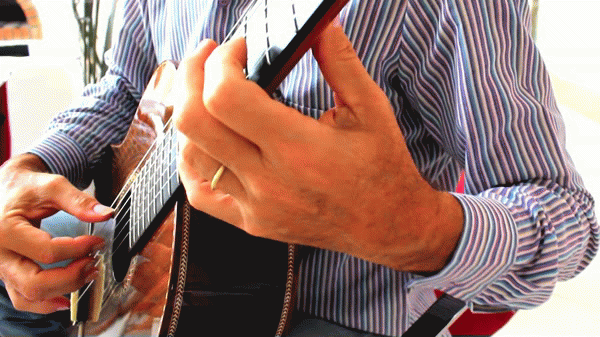
Below is the same movement taken from a different angle.
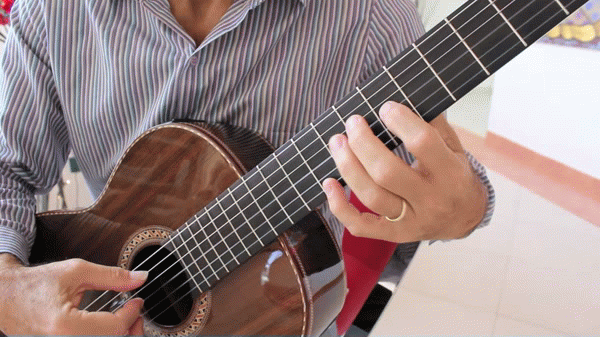

I invite you to work this beautiful classical guitar piece online with me following this link.
We will look deeper to the 3 of them. Position B is Carlevaro's Transversal. It is often challenging to find the correct word to define something. The challenge is even greater when translating from one language to the other.
Simple Forms: Longitudinal Presentation
The best example to describe this presentation is the form that our hand and fingers acquire when playing a chromatic scale. The fingers are parallel with respect to the frets. Most scales and runs require this type of presentation. Each one of the fingers in the left hand occupies one fret on the fingerboard and the knuckles in the left hand run parallel with the strings. The left hand thumb works like a pivot which lifts the hand and presents the fingers on the different strings.
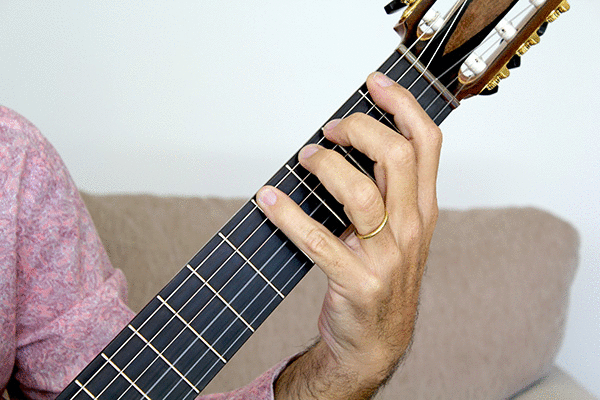
Notice how the shape and distribution of the hand and fingers remains the same. Everything from the wrist up moves and adapts accordingly. You can also see how the right hand fingers stay the same, what moves them from string to string is the correct use of the wrist articulation. The wrist is made up of many, small, very movable bones, ideal for the work of guitarists.
Position B (Transversal Presentation)
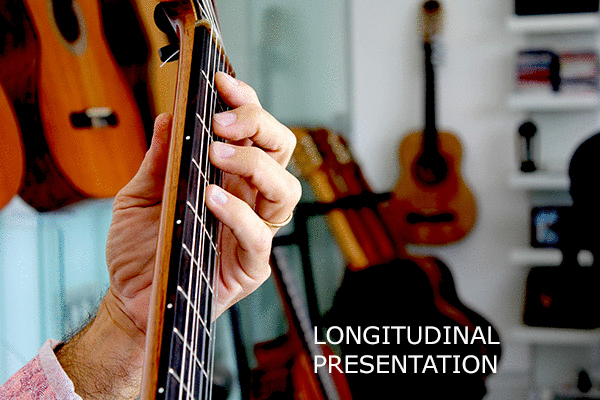
In this animation I show the concept of "presentation". I passes from a "Longitudinal Presentation" in "the first frame and move to a "Transversal Presentation" in the last frame. It all happens thanks to a rotation of the left forearm & wrist.
Combined or Mixed Forms
Combined forms are a mixture of the 2 simple forms. They pose a very special challenge.
You must be asking yourself -"Why do I have to know about these forms, or how they are named, or even give them a name of my own?". The answer is in the word "name". When you call someone or something by its name, your brain uses a whole different set of synapses than if you ignored the "name" completely. We better know how we work, because otherwise, we will simply not work.
A great example of a combined form, is the first measure of staff 2 in Cavatina. You can learn more about the way to study Stanley Myers'' "Cavatina" here.
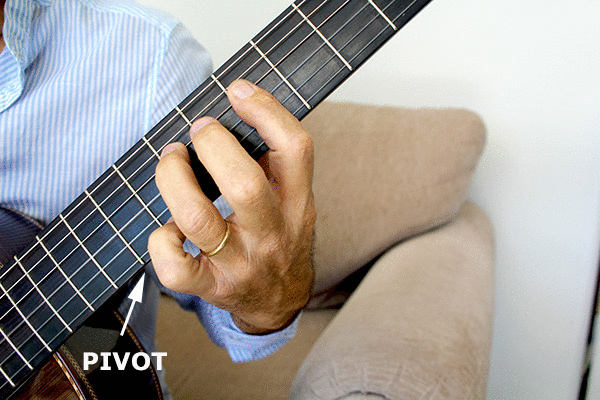
Animation from Gavottes 1 & 2.
The way your brain must see this position is the following: The Barre with 1 is accomplished with a simple longitudinal presentation while fingers 2, 3 and 4 are pressing the strings using a simple transversal presentation.
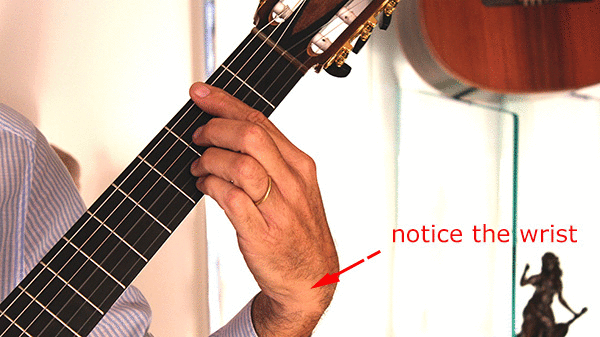
In the above sequence from "Il Postino", you can see the hand pass from a Transversal Presentation, then, using finger 4 as an anchor, the wrist comes forward and the left hand passes through a Mixed Presentation to finish up in a Longitudinal presentation stopping the G# on string 3. Notice how the arm (forearm and shoulder) is involved in the mechanics to achieve the passage through all 3 types of presentations.
Below is a good example taken from Handel Passacalle. in staff #6 the Left Hand goes to first position and as it does, teh hand gets in teh Mixed Form configuration in the air
Below a yet another sequence of Left Hand Changes of Presentations from Handel Passacalle Staff #4
Below Passacalle staff #6
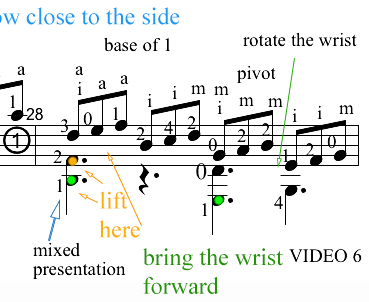
Left Hand Stretches & Contractions
The fingers in the left hand are often called in to perform either stretches or Contractions. These are the 2 sides of the same coin and typically, one is immediately followed by the other so as to compensate for the instability that both generate in the left hand. The active participation of the arm, wrist and shoulder is essential in achieving good stretches that will cause as little strain and string squeaks as possible.
STRETCHES
The Left hand fingers will often need to stretch beyond the natural 4-frets span. When this happens, it is necessary to use the whole playing apparatus (The "whole" playing apparatus consists of the wrist, forearm, elbow, shoulder and to different degrees of involvement, the torso and legs) in order to carry on the task using more powerful and more adapt muscle groups. Leaving all the work to the fingers alone will augment the risk of mistakes and the mount up of muscular fatigue. Larger muscle groups achieve greater precision with greater ease. The exercise I perform in the video is from the opening stretch in Recuerdos de la Alhambra.
One Great Scenario for LH Stretches is Bach Fugue BWV 1000. In staff #18, the player is required to prepare a chord "in the air" while performing a big stretch that demands that the whole playing apparatus get involved. The stretch happens at the very beginning where it says "stretch" in the score below. Look at the animation further down. Study Fugue BWV 1000 with me here →

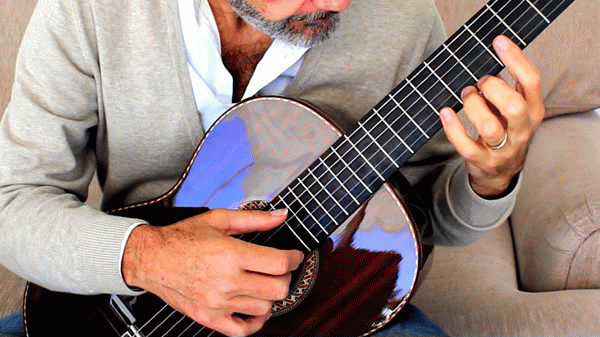
Below is another great Stretch Scenario From Handel Passacalle, Staff #3
CONTRACTIONS
Below is a contraction scenario from Handel Passacalle Staff #5

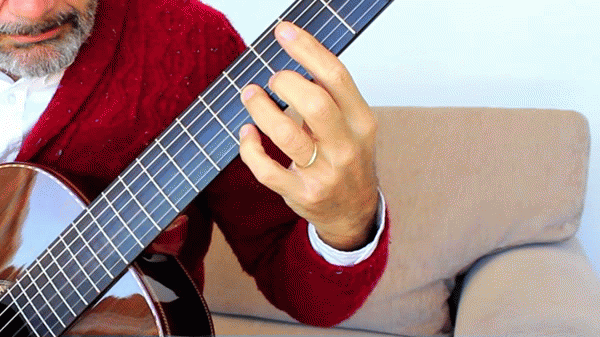
The continuation of this class is in the members area, become a member today.
 Back to Top
Back to Top



